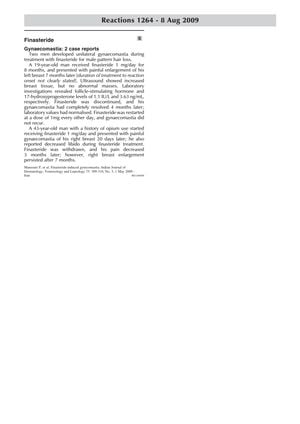Fluoxetine
August 2009
in “
Reactions Weekly
”

TLDR Finasteride caused breast enlargement in two men, which improved after stopping the medication.
Two men, aged 19 and 43, developed unilateral gynaecomastia while being treated with finasteride 1 mg/day for male pattern hair loss. The 19-year-old experienced painful enlargement of his left breast after 7 months of treatment, which resolved completely 4 months after discontinuing finasteride; his hormone levels also normalized. When finasteride was reintroduced at a reduced frequency, the gynaecomastia did not recur. The 43-year-old developed painful gynaecomastia in his right breast 20 days after starting finasteride and reported decreased libido. His pain decreased 3 months after stopping the medication, but the breast enlargement persisted after 7 months.



